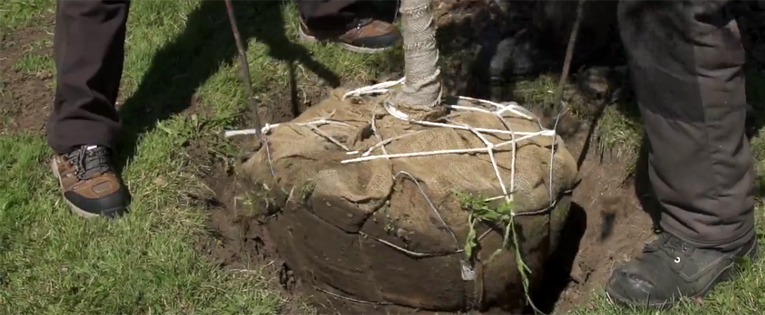Ensuring that your tree is properly planted is critical to the long term good health and vitality of your tree. You may have planted a new tree for future benefits, only to discover 8 – 10 years later that the reason for your tree’s early demise is improper planting. Ontree has the knowledge and experience to ensure your tree is correctly planted and given the best possible start to becoming a long lived and valuable asset.
Trees should be planted in early spring before bud break, or in the fall after leaf drop. For practical reasons, spring is usually a better time to plant because nurseries have just received new stock and choices are much greater. Trees can also be planted during the growing season, but watering at that time becomes even more critical.
Most new trees come wrapped in burlap and it is important to realize that 90% or more of the root system was likely removed during processing. Trees dug for transplanting therefore typically go into transplant shock which could result in leaf drop, slow growth, and reduced vigour. Preparing the planting site properly and providing good follow up care are critical factors that will determine if your new tree will survive and thrive:
- A planting hole should be several times wider than the root ball, but no deeper than the root ball. Digging the planting hole this way will break up the soil beyond the root ball and allow new roots to penetrate more readily into the native soil. The biggest cause of young tree and shrub failure is planting too deeply. Never dig the hole deeper than the depth of the root ball.
- Place the tree into the hole and make sure the hole is not too deep. Confirm proper depth by ensuring trunk flare is visible above grade at all times. It is always better to plant the tree a little higher (2-3” above base of the trunk flare) than too deep.
- Always remove the twine or nylon and the burlap. Cut back the wire basket at least 1/3 down the depth of the root ball. This process will remove barriers that may restrict quick and effective root growth. Ensure trunk is straight.
- Break up soil dug from the hole and use as back fill. Fill the hole gently but firmly – do not tamper as this will compact soil and make root penetration difficult.
- Create a berm made of soil around the edge of the planting hole. This will allow water to be directed into the rooting area more directly.
- Water soil in and mulch the top of soil back fill and root ball with 2-3” of wood chips in a 3’ radius, but keeping mulch away from trunk of tree.
- Stake tree if conditions warrant. Stakes should be removed after 1-2 growing seasons.
- Follow up care will consist primarily of watering. Soil should be kept moist, but not soaked, and the root ball should never be allowed to dry out. Newly planted trees should be watered one to three times per week, depending on temperature, rainfall and soil conditions. For most trees in the 40-60mm caliper range, one to two 8 liter buckets of water per watering will suffice. Watering should continue until mid- fall, but can taper off as temperatures drop. This watering program should continue for two to three years following planting.



Most Commented Posts